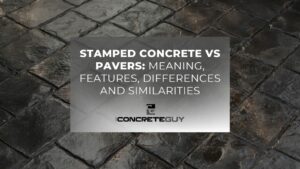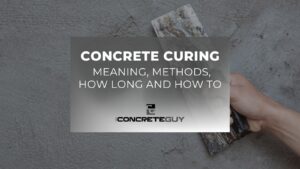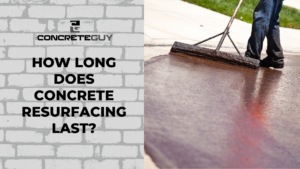Dry pouring refers to a method of concrete placement where the dry concrete mix is poured into a form or mold, followed by the addition of water to initiate hydration and curing.
Dry pouring, also known as dry mix concrete placement, includes pre-mixing concrete ingredients before pouring into formwork and adding water on-site. Alternatively, dry pouring involves layering dry concrete mix and water in formwork or using specialized equipment like dry mix trucks for blending on-site, reducing the need for on-site mixing and ensuring consistent concrete quality in construction.
The duration of dry pouring varies depending on factors such as the type of concrete mix used, ambient conditions, and project requirements. Generally, the process involves efficiently pre-mixing concrete ingredients and adding water on-site, which saves time compared to traditional wet mixing methods.
What Is Dry Pouring a Concrete Slab?
Dry pouring a concrete slab is a method of concrete placement where the dry concrete mix is poured into a form or mold, and then water is added on-site to initiate hydration and curing. This approach offers advantages such as better control over mix consistency, reduced labor during mixing, and minimized chances of over-watering the concrete. Dry pouring is commonly used in construction projects where precision, efficiency, and quality control are important considerations.
Dry pouring is often considered easier than wet pouring because it eliminates the step of mixing the concrete first. However, dry pouring has several disadvantages, including a lower quality final product, a higher risk of cracking or uneven surfaces, and a higher potential for costly repairs or replacements.
Dry pouring is not recommended for projects where the load-bearing capacity of concrete is important and reinforcement is required, such as concrete driveways or sidewalks.
It is also not recommended for slabs in cold climates, as it will not be able to withstand the internal pressures caused by frequent freeze-thaw cycles. Dry pouring is not a viable option for projects where the appearance of the concrete is important, as it cannot be integrally colored or stamped.
The method is not recommended for large-scale projects, but it is acceptable for small slabs that won’t bear much weight and where the appearance of the slab is not critical, such as the floor of a tool shed or the base for an air-conditioning unit
How to Dry Pour a Concrete Slab
Dry pouring a concrete slab involves a systematic process to achieve optimal results:
- Surface Preparation: Ensure the base surface is properly compacted, graded, and free of debris before pouring the concrete.
- Formwork Design and Setup: Design and construct formwork to the desired dimensions and specifications, ensuring it is level, securely anchored, and accommodates any specific features or requirements of the slab.
- Mix the Dry Concrete: Thoroughly pre-mix the dry concrete ingredients according to the manufacturer’s specifications, either using a concrete mixer or manually in a mixing tub or wheelbarrow.
- Pour the Dry Concrete: Carefully pour the mixed dry concrete into the prepared formwork, ensuring even distribution and proper compaction. Use a shovel or rake to spread the concrete and fill any gaps or voids in the formwork.
- Add Water: Gradually add water on-site to the poured dry concrete mix, starting at one corner and working your way across the slab. Aim for a moist but not saturated consistency, avoiding over-watering.
- Reinforcement: If necessary, add reinforcement such as rebar or wire mesh within the concrete slab for added strength and durability.
- Consolidate and Level: Use a vibrating screed or a tamping tool to consolidate the concrete and remove air pockets. Use a bull float to level the surface, moving it in long, smooth strokes to achieve a flat and even finish.
- Finishing Techniques: Use a trowel to smooth the surface further and create a professional finish. Consider applying a surface sealer or using other finishing techniques for aesthetic and functional purposes.
- Curing: Cover the slab with a curing compound or use moist curing methods to promote proper hydration and strength development. Protect the slab from excessive moisture loss during the curing process, especially in hot or windy conditions.
- Final Inspection: After the concrete has cured sufficiently, perform a final inspection to ensure the slab meets quality standards and specifications.
What Are the Benefits of Dry Pouring?
Dry pouring, also known as dry mix concrete placement, offers several benefits compared to traditional wet mixing methods:
- Better Control Over Mix Consistency: Pre-mixing dry concrete ingredients allows for precise control over the mix’s composition, ensuring consistent quality and performance.
- Reduced Labor and Equipment Requirements: Dry pouring eliminates the need for on-site concrete mixing equipment, reducing labor costs and equipment setup time.
- Minimized Environmental Impact: By reducing water usage and eliminating excess water runoff, dry pouring has a lower environmental impact compared to wet mixing methods.
- Improved Workability and Placement: Dry mix concrete tends to be more workable and easier to handle during placement, leading to smoother and more uniform finishes.
- Reduced Risk of Over-Watering: Since water is added on-site, dry pouring minimizes the risk of over-watering the concrete mix, which weakens the final product and leads to cracking.
- Enhanced Strength and Durability: Properly executed dry pouring results in concrete with enhanced strength, durability, and resistance to cracking, improving the longevity of the structure.
- Faster Construction Times: The efficiency of pre-mixed dry concrete and the simplified placement process lead to faster construction times and shorter project durations.
- Flexibility in Project Scheduling: Dry pouring allows for more flexibility in project scheduling since concrete mixtures are prepared in advance and used as needed, reducing downtime and delays.
The benefits of dry pouring make it an attractive option for construction projects that require efficient, high-quality concrete placement with reduced labor and environmental impact.
What Are the Disadvantages of Dry Pouring?
While dry pouring offers several benefits, it also has some potential disadvantages that need to be considered:
- Mixing Consistency Challenges: Achieving consistent mixing of dry concrete ingredients is challenging, especially when done manually or without proper equipment, which results in variations in concrete quality.
- Limited Workability Time: Dry mix concrete has a limited workability time once water is added, requiring quick and efficient placement to avoid premature setting or drying out.
- Potential for Segregation: Improper mixing or handling of the dry concrete mix during pouring breeds segregation, where larger aggregate particles settle at the bottom, affecting the uniformity and strength of the concrete.
- Increased Risk of Air Pockets: Inadequate consolidation and compaction during dry pouring whose ramifications are the formation of air pockets or voids within the concrete, compromising its structural integrity.
- Higher Initial Costs: Setting up and using specialized equipment for dry pouring, such as dry mix trucks or mixing systems, involves higher initial costs compared to traditional wet mixing methods.
- Limited Application in Certain Conditions: Dry pouring is not suitable for all construction conditions, such as extremely hot or windy environments, where rapid moisture loss occurs, affecting concrete quality and curing.
- Curing Challenges: Proper curing of dry-poured concrete is essential to achieve optimal strength and durability. However, ensuring adequate moisture retention and temperature control during curing is more challenging compared to wet-mixed concrete.
- Less Flexibility in Adjusting Mix Consistency: Once water is added to dry concrete mix, there is limited flexibility in adjusting the mix consistency, requiring careful planning and execution during placement.
Despite these potential disadvantages, many of these challenges are mitigated through proper planning, equipment selection, and adherence to best practices in dry pouring techniques. It’s essential to assess the specific project requirements and conditions to determine the suitability of dry pouring for a given construction project.
What are the Types of Formwork and Materials used in Dry Pouring?
Formwork is a crucial component in the construction of concrete structures, providing the framework and support for poured concrete until it cures and gains sufficient strength. Various types of formwork are used in construction, each with its materials, advantages, and applications:
- Timber Formwork: Timber formwork, often made from plywood, timber beams, and props, is commonly used for small to medium-sized projects due to its versatility and cost-effectiveness. It is easy to work with and reused multiple times with proper maintenance, and allows for customization to accommodate different shapes and sizes.
- Steel Formwork: Steel formwork, made from steel sheets, angles, and props, offers durability, strength, and stability, making it suitable for large-scale and complex projects. It provides excellent dimensional accuracy, withstands high pressures from concrete pouring, and is reusable, leading to cost savings over multiple uses.
- Aluminum Formwork: Aluminum formwork, composed of aluminum panels, beams, and connectors, is lightweight, durable, and easy to assemble and dismantle. It is suitable for repetitive use in residential and commercial projects, offering fast construction cycles and high-quality finishes.
- Plastic Formwork: Plastic formwork, typically made from polypropylene or PVC, is lightweight, reusable, and resistant to moisture and chemicals. It is ideal for projects requiring quick assembly and demolding, such as in-situ concrete walls and columns, and offers excellent surface finishes.
- Fabric Formwork: Fabric formwork, using flexible fabric membranes supported by temporary structures, is used for creating curved or irregular-shaped concrete elements. It allows for artistic and innovative designs, is lightweight and easy to transport, and minimizes the need for traditional rigid formwork materials.
- Engineered Formwork Systems: Engineered formwork systems, such as modular formwork systems or prefabricated formwork elements, offer efficient and standardized solutions for repetitive construction tasks. They are designed for easy assembly, reusability, and compatibility with various construction methods and project requirements.
Each formwork type and material has its advantages and limitations, and the selection depends on factors such as project scope, complexity, budget, timeline, and desired concrete finish. Proper formwork design, installation, and maintenance are crucial for ensuring safe, efficient, and high-quality concrete construction.
What are the Reinforcement Options of Concrete Slabs?
Reinforcement plays a crucial role in enhancing the strength, durability, and structural integrity of concrete elements, especially in applications where the concrete is subjected to tensile forces or heavy loads. Various reinforcement options are available, each offering unique benefits and applications:
- Rebar (Reinforcing Bar): Rebar consists of steel bars or rods placed within concrete structures to provide tensile strength and resist cracking under tension. It is commonly used in reinforced concrete beams, columns, slabs, and foundations, offering excellent structural support and load-bearing capacity.
- Wire Mesh: Wire mesh reinforcement comprises interconnected steel wires or grids placed in concrete to distribute loads and improve crack resistance. It is often used in flat concrete elements like driveways, sidewalks, and slabs to control cracking and improve overall durability.
- Fiber Reinforcement: Fiber reinforcement involves adding synthetic or steel fibers to the concrete mix to enhance flexural strength, impact resistance, and durability. Fiber reinforcement is commonly used in industrial floors, precast concrete elements, and shotcrete applications to improve toughness and reduce cracking.
- Post-Tensioning: Post-tensioning is a method where high-strength steel tendons are placed within concrete elements and tensioned after the concrete has hardened. This technique increases the concrete’s load-carrying capacity, reduces deflections, and allows for longer spans in structural elements like beams, slabs, and bridges.
- Pre-Stressed Concrete: Pre-stressed concrete involves embedding high-strength steel tendons or cables in concrete elements before casting and then applying tension to the tendons after the concrete has cured. This technique induces compression in the concrete, enhancing its resistance to tensile forces and improving overall structural performance in bridges, buildings, and infrastructure projects.
- Mesh Sheets: Mesh sheets, similar to wire mesh but in a sheet form, provide reinforcement and crack control in concrete elements like walls, columns, and footings. They are easy to install, cost-effective, and offer improved structural stability and durability.
- Carbon Fiber Reinforcement: Carbon fiber reinforcement involves using carbon fiber sheets or strips bonded to concrete surfaces to improve flexural strength, stiffness, and resistance to external forces. It is commonly used in retrofitting existing structures, repairing concrete cracks, and strengthening concrete elements in high-stress areas.
The selection of reinforcement options depends on factors such as structural design requirements, loading conditions, environmental factors, project specifications, and budget considerations. Proper placement, detailing, and compatibility with the concrete mix are essential to ensure effective reinforcement and long-term performance of concrete structures.
Does dry pouring be used for all types of concrete projects?
Dry pouring is suitable for a wide range of concrete projects, including slabs, floors, walls, and columns. However, it is essential to assess project requirements, environmental conditions, and concrete mix design to determine the suitability of dry pouring for a specific application.
How does dry pouring affect concrete curing and strength development?
Dry pouring involves adding water on-site to initiate hydration and curing of the concrete mix. Proper moisture control and curing practices are essential to ensure optimal strength development and durability in dry-poured concrete slabs.
What are the advantages of using dry pouring over traditional wet mixing methods?
The advantages of dry pouring over wet pouring includes mix consistency, reduced labor and equipment requirements, minimized environmental impact, improved workability, and enhanced strength and durability of concrete slabs.
Is reinforcement used in dry-poured concrete slabs?
Yes, reinforcement options such as rebar, wire mesh, fiber reinforcement, and post-tensioning are used in dry-poured concrete slabs to enhance structural integrity, resist cracking, and improve load-bearing capacity.
What surface finishes are compatible with dry-poured concrete slabs?
Dry-poured concrete slabs are finished using various techniques such as broom finish, trowel finish, exposed aggregate finish, stamped concrete, polished finish, acid stain finish, and sealed finish, depending on the desired aesthetics and functionality of the slab.









